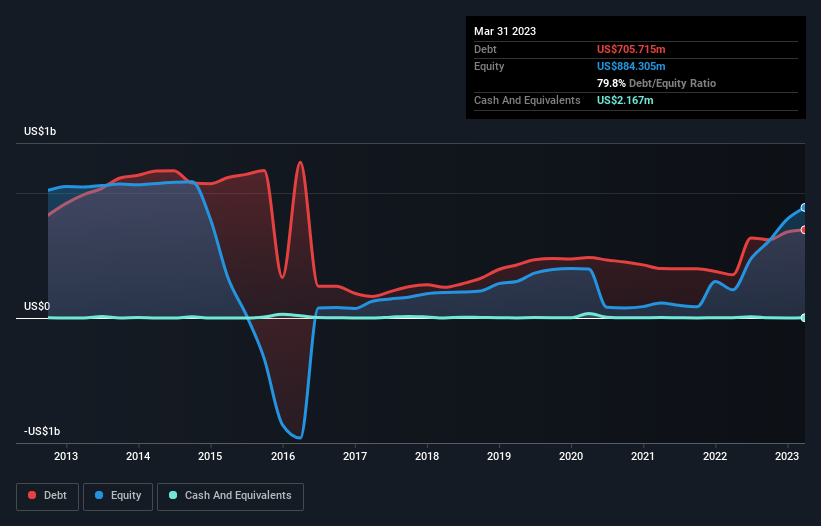- United States
- /
- Oil and Gas
- /
- NYSE:SBOW
These 4 Measures Indicate That SilverBow Resources (NYSE:SBOW) Is Using Debt Extensively
Legendary fund manager Li Lu (who Charlie Munger backed) once said, 'The biggest investment risk is not the volatility of prices, but whether you will suffer a permanent loss of capital.' When we think about how risky a company is, we always like to look at its use of debt, since debt overload can lead to ruin. Importantly, SilverBow Resources, Inc. (NYSE:SBOW) does carry debt. But the real question is whether this debt is making the company risky.
What Risk Does Debt Bring?
Debt is a tool to help businesses grow, but if a business is incapable of paying off its lenders, then it exists at their mercy. If things get really bad, the lenders can take control of the business. While that is not too common, we often do see indebted companies permanently diluting shareholders because lenders force them to raise capital at a distressed price. Having said that, the most common situation is where a company manages its debt reasonably well - and to its own advantage. The first step when considering a company's debt levels is to consider its cash and debt together.
Check out our latest analysis for SilverBow Resources
What Is SilverBow Resources's Debt?
As you can see below, at the end of March 2023, SilverBow Resources had US$705.7m of debt, up from US$346.0m a year ago. Click the image for more detail. And it doesn't have much cash, so its net debt is about the same.

How Healthy Is SilverBow Resources' Balance Sheet?
According to the last reported balance sheet, SilverBow Resources had liabilities of US$136.4m due within 12 months, and liabilities of US$764.2m due beyond 12 months. Offsetting this, it had US$2.17m in cash and US$63.9m in receivables that were due within 12 months. So its liabilities total US$834.5m more than the combination of its cash and short-term receivables.
When you consider that this deficiency exceeds the company's US$702.2m market capitalization, you might well be inclined to review the balance sheet intently. Hypothetically, extremely heavy dilution would be required if the company were forced to pay down its liabilities by raising capital at the current share price.
In order to size up a company's debt relative to its earnings, we calculate its net debt divided by its earnings before interest, tax, depreciation, and amortization (EBITDA) and its earnings before interest and tax (EBIT) divided by its interest expense (its interest cover). The advantage of this approach is that we take into account both the absolute quantum of debt (with net debt to EBITDA) and the actual interest expenses associated with that debt (with its interest cover ratio).
SilverBow Resources's net debt is only 0.94 times its EBITDA. And its EBIT covers its interest expense a whopping 11.6 times over. So we're pretty relaxed about its super-conservative use of debt. Even more impressive was the fact that SilverBow Resources grew its EBIT by 2,140% over twelve months. If maintained that growth will make the debt even more manageable in the years ahead. When analysing debt levels, the balance sheet is the obvious place to start. But ultimately the future profitability of the business will decide if SilverBow Resources can strengthen its balance sheet over time. So if you want to see what the professionals think, you might find this free report on analyst profit forecasts to be interesting.
But our final consideration is also important, because a company cannot pay debt with paper profits; it needs cold hard cash. So the logical step is to look at the proportion of that EBIT that is matched by actual free cash flow. During the last three years, SilverBow Resources burned a lot of cash. While that may be a result of expenditure for growth, it does make the debt far more risky.
Our View
While SilverBow Resources's conversion of EBIT to free cash flow has us nervous. To wit both its EBIT growth rate and interest cover were encouraging signs. Taking the abovementioned factors together we do think SilverBow Resources's debt poses some risks to the business. So while that leverage does boost returns on equity, we wouldn't really want to see it increase from here. The balance sheet is clearly the area to focus on when you are analysing debt. But ultimately, every company can contain risks that exist outside of the balance sheet. For example, we've discovered 4 warning signs for SilverBow Resources (2 are a bit concerning!) that you should be aware of before investing here.
At the end of the day, it's often better to focus on companies that are free from net debt. You can access our special list of such companies (all with a track record of profit growth). It's free.
New: Manage All Your Stock Portfolios in One Place
We've created the ultimate portfolio companion for stock investors, and it's free.
• Connect an unlimited number of Portfolios and see your total in one currency
• Be alerted to new Warning Signs or Risks via email or mobile
• Track the Fair Value of your stocks
Have feedback on this article? Concerned about the content? Get in touch with us directly. Alternatively, email editorial-team (at) simplywallst.com.
This article by Simply Wall St is general in nature. We provide commentary based on historical data and analyst forecasts only using an unbiased methodology and our articles are not intended to be financial advice. It does not constitute a recommendation to buy or sell any stock, and does not take account of your objectives, or your financial situation. We aim to bring you long-term focused analysis driven by fundamental data. Note that our analysis may not factor in the latest price-sensitive company announcements or qualitative material. Simply Wall St has no position in any stocks mentioned.
About NYSE:SBOW
SilverBow Resources
An independent oil and gas company, exploration, develops, acquires, and operates oil and natural gas properties in the Eagle Ford shale and Austin Chalk located in South Texas.
Very undervalued slight.
Similar Companies
Market Insights
Community Narratives



